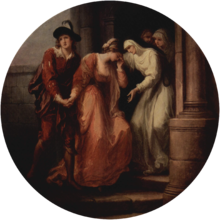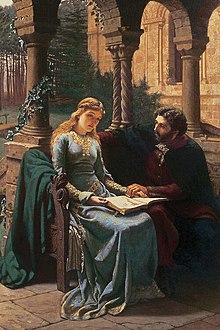Heloisa



Heloisa (* around 1095 in the Loire region; † around 1164 in the Le Paraclet monastery near Nogent-sur-Seine ), French Héloïse or Héloise , German also called Heloïse or Heloise , was the wife of the philosopher and theologian Peter Abelard and abbess of the women's convent Le Paraclet, which was founded according to Cistercian and Fontevraldens models and exegetically supported by Abelard's writings .
Life
Heloisa was probably the daughter of the Angevin nobles and later prioress of Fontevrault Abbey , Hersendis of Champagne ; her father's name is unknown. Immediately after birth, Heloisa came to the nunnery of Notre-Dame d'Argenteuil for early monastic education , apparently her uncle Fulbert , who had meanwhile risen to the position of subdeacon of Notre Dame in Paris , had a kind of supervisory duty and guardian role.
Later - around 1116/1117 - Heloisa met and fell in love with Peter Abelard. Abelard, a lecturer at the dialectic chair in Paris, initially hired himself as Heloisa's tutor and the two entered into a passionate but secret love affair. After a while, however, the affair became known. Abelard had his lover, who had meanwhile become pregnant by him, secretly brought to Le Pallet , where she gave birth to her son Astralabius .
After that, Heloisa returned to Paris at the request of Abelard, who had meanwhile come to terms with her uncle Fulbert, and was married to her lover against her will, but in accordance with the requirements of canon law, which subsequently legitimized the previous confinement and a public scandal initially avoided. But in the same year Uncle Fulbert, who was thinking of revenge, arranged for Abelard to be castrated . He survived the mutilation and retired as a monk in the Saint-Denis monastery . He instructed Heloisa to retire to the nunnery in Argenteuil, with which he wanted to make her remarriage impossible in the event of a subsequent divorce.
In 1118 Heloisa entered the Benedictine convent of Argenteuil, where she had already spent her childhood, and made perpetual vows. There she was possibly prioress from 1123 until Abbot Suger of Saint-Denis dissolved the convent in 1129 and expelled the nuns from the convent.
Only during this time - after more than ten years - did the contact between Heloisa and Abelard revive. The 32-year-old religious finally found a new home with a group of nuns in Abelard's abandoned hermitage Paraklet near Nogent-sur-Seine . As prioress, later as abbess, Heloisa built a new women's convent there, which was based on a simplified Benedictine rule, e.g. Partly according to Abelard's suggestions, lived. The convent grew rapidly under Heloisa's wise leadership and at the time of her death consisted of five priories and a branch monastery. Abelard remained in letters to Heloisa and the monastery as an advisor until his death.
The couple's correspondence made it famous. In her letters, Heloisa turned out to be not only a woman of extraordinary intellectual and heart formation, but also a gifted writer in the subtlety and elegance of her formulations, as was later confirmed by a contemporary ( Hugo Metellus from Toul).
In 1131, Pope Innocent II placed the Paraclete Monastery of Heloisas under direct papal direction, but this did not prevent him from condemning Abelard as a heretic ten years later at the Council of Sens . Peter Abelard died in the spring of 1142. A little later, Petrus Venerabilis , the Grand Abbot of the Cluny Monastery , personally brought Abelard's bones to the Paraklet Monastery for burial. It was not until 22 years later, in 1164, that Heloisa died there after a long time as a recognized head of the order. She was buried next to her beloved Abelard in the Petit Moustier chapel.
After the monastery was closed during the French Revolution in 1792 and almost completely destroyed, a neo-Gothic tomb was erected in 1817 in honor of Heloisas and Abelard in the Père Lachaise cemetery in Paris , where the scant remains of their corpses were placed.
Use of the subject
- Jean-Jacques Rousseau : Julie ou la Nouvelle Héloïse . Novel 1761
- Jakob Michael Reinhold Lenz : The Hofmeister or advantages of private education , comedy 1774
- Hannes Anderer : Meeting with Melusine. Book 2. Sonnenberg, Annweiler 2007 (the protagonists are called Heloise and Abelard)
- Maren Bohm: Heloisa or The Expulsion from Paradise , Karl Alber Verlag, Freiburg / Munich 2018 (philosophical novel)
literature
- Regina Heyder : Gender concepts of a spiritual couple: Abelard and Heloise : In: Rottenburger Jahrbuch für Kirchengeschichte 35 (2016), pp. 29–55. Open Access.
- Hans-Wolfgang Krautz (ed., Translator), Petrus Abaelardus: The exchange of letters with Heloisa , Reclam-Verlag, 2001, ISBN 3-15-003288-1
- Jörg Ulrich : HELOISA. In: Biographisch-Bibliographisches Kirchenlexikon (BBKL). Volume 16, Bautz, Herzberg 1999, ISBN 3-88309-079-4 , Sp. 670-676.
- Christian Zitzl; Klaus U. Dürr, Reinhard Heydenreich (eds.): Abelard and Héloise . The tragedy of a great love. Buchner, Bamberg 2007, ISBN 978-3-7661-5738-6 (German / Latin.).
Web links
- Werner Robl: Heloïsa's origin: Hersindis Mater
- Werner Robl: Hersindis Mater: News on the family history of Heloisas with views of the Peter Abelard family
- Literature by and about Heloisa in the catalog of the German National Library
Individual evidence
- ↑ Werner Robl: Heloisas origin: Hersendis mater . ( academia.edu [accessed December 27, 2019]).
| personal data | |
|---|---|
| SURNAME | Heloisa |
| ALTERNATIVE NAMES | Heloise |
| BRIEF DESCRIPTION | Wife of Petrus Abelardus, abbess |
| DATE OF BIRTH | around 1095 |
| PLACE OF BIRTH | uncertain: Paris |
| DATE OF DEATH | around 1164 |
| Place of death | Le Paraclet monastery near Nogent-sur-Seine |
